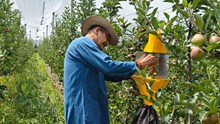
In a land where farming is often bound by tradition and generations till the same soil in the same way, a few individuals rise above convention to reimagine what agriculture can be. These are the dreamers, the doers—the pioneers who believe that the earth holds more than just crops; it holds possibilities. Among them is Milan Singh Vishwakarma, a visionary farmer from the Mahasamund district of Chhattisgarh, whose journey from hardship to national acclaim is lighting the way for a new era of agri-entrepreneurs in India.
At a time when most farmers in his region remained dependent on paddy and seasonal crops, Milan Singh dared to chart a different course. With little more than determination, resilience, and a deep connection to the land, he ventured into the lesser-known world of lac farming—a natural resin cultivation practice with ancient roots but untapped modern potential. Through years of dedication and innovation, Milan Singh transformed not just his own livelihood but also the perception of what is possible in rural farming.
Today, he stands as a symbol of hope and transformation earning lakhs annually from his 26-acre lac farm, and honored with district, state, and national awards. His story is a testament to the power of courage, knowledge, and the unyielding spirit of a farmer who chose not to follow the crowd, but to lead it. This is the inspiring story of Milan Singh Vishwakarma, Chhattisgarh’s lac farming trailblazer and a proud face of India’s agricultural renaissance.

Early Life and Turning Point
Milan Singh’s journey began in a modest farming family. Having completed his education only up to the 12th grade, he initially engaged in cultivating conventional crops such as paddy and pulses. However, low returns and increasing input costs made it difficult for him to sustain his livelihood. His search for a viable and sustainable alternative led him to an agricultural innovation that would change his life forever lac farming.
The turning point came in 2002 when scientists from the Indian Institute of Natural Resins and Gums (IINRG), Ranchi, visited Mahasamund and demonstrated how scientific techniques could drastically improve lac yields and profitability. Inspired by their insights, Milan Singh began experimenting with modern lac farming techniques and the results were astonishing.

Large-Scale Lac Cultivation
Today, Milan Singh cultivates lac on an impressive 26 acres of land, where he has planted host trees such as Palash, Ber, and Semialata, which support the lac insects. Unlike monocropping, he practices mixed farming by growing vegetables, pulses, and oilseeds alongside lac, which not only ensures crop diversity but also adds to his income stability.
He cultivates two major varieties of lac:
-
Kusumi Lac: Harvested in two cycles, from July–January and January–July. It is known for its high quality and commands better prices in the market.
-
Rangini Lac: Typically harvested in July–November and again from November–July. While profitable, Rangini lac faces more challenges in off-season months.

Yields, Income & Market Value
Under ideal temperature conditions ranging between 17 and 36 degree celcius, Milan Singh achieves yields of:
-
Kusumi Lac: 6 to 10 quintals per acre
-
Rangini Lac: 8 to 20 quintals per acre (especially on Ber trees)
The average market rate of lac hovers around Rs. 700 per kilogram. What’s remarkable is that traders visit farmers directly to procure the produce, saving them the burden of transportation and helping them retain a greater share of the profits. This has enabled Milan Singh to earn lakhs of rupees in net profit annually from his lac farming operations.

Environmental and Industrial Benefits
Milan Singh emphasizes that lac farming is both economically and environmentally beneficial. The lac resin harvested from trees is a valuable raw material for several industries, used in the production of:
-
Artificial jewellery
-
Decorative items
-
Adhesives and resins
-
Varnishes and sealing wax
Moreover, host trees like Palash and Ber contribute significantly to the local ecology by increasing green cover, conserving soil, and combating the effects of climate change. Lac farming thus serves as a dual-purpose model—supporting both livelihoods and the environment.

Overcoming Challenges
Lac farming is not without its difficulties. The major concerns include pest attacks and fungal infections, especially during the rainy season. Milan Singh tackles these challenges through timely interventions, organic treatments, and regular consultations with agricultural scientists. His integrated pest management strategy not only protects the crop but also promotes eco-friendly farming.

Recognition and Contribution to GFBN
For his outstanding work, Milan Singh Vishwakarma has received multiple honors at the district, state, and national levels. His expertise in sustainable agriculture and lac entrepreneurship has made him a role model for thousands of farmers across India.
Recently, he joined the Global Farmer Business Network (GFBN), a national initiative by Krishi Jagran aimed at nurturing agri-entrepreneurs and spreading best practices among farming communities. As a GFBN member, Milan Singh now shares his knowledge and mentors aspiring farmers on how to adopt lac farming and transform their economic futures.

Milan Singh Vishwakarma’s journey is a shining example of what can be achieved through adaptability, innovation, and scientific knowledge. He turned a once low-return livelihood into a thriving agribusiness, all while maintaining ecological balance and inspiring a new generation of farmers. His story serves as a powerful message: if one is willing to learn and evolve, farming in India can become a highly profitable and respected profession.
Note: Global Farmer Business Network (GFBN) is a dynamic platform where agricultural professionals—farmer entrepreneurs, innovators, buyers, investors, and policymakers - converge to share knowledge, experiences, and scale their businesses. Powered by Krishi Jagran, GFBN facilitates meaningful connections and collaborative learning opportunities that drive agricultural innovation and sustainable development through shared expertise. Join GFBN today: https://millionairefarmer.in/gfbn
















